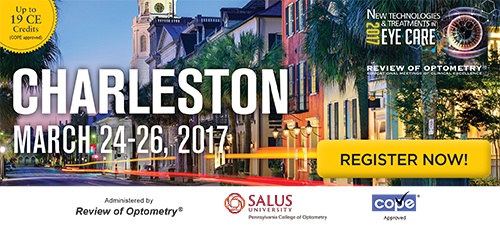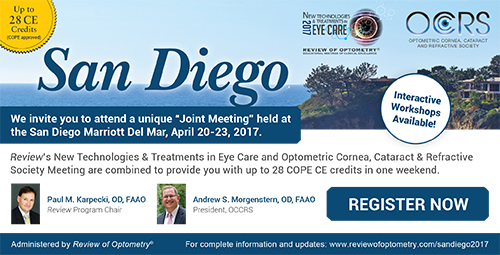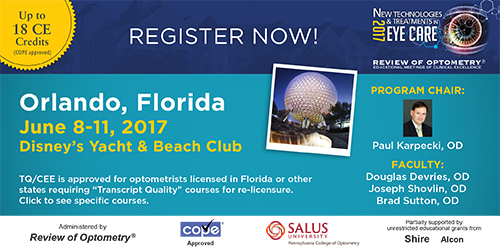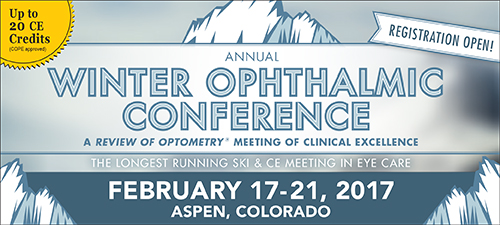
A
weekly e-journal by Art Epstein, OD, FAAO
Off the Cuff: Finding Your Niche
In a recent Off The Cuff, I wrote about the likely impact of new technology on our profession. In short, if you earn most of your income providing refractions and selling eyeglasses, you would be wise to think about what you will be doing in the next five years. That said, I remain bullish on optometry and our profession’s future—a future that will be very different than today. Over the coming months, I will be focusing on developing unique niches that can transform our practices clinically and provide safe and economically successful safe harbors. Few ODs know as much about practice success as does my friend Dr. Gary Gerber. In our early years, Gary and his Power Practice team helped us plan our practice and were instrumental in its success. Recently, Gary partnered with Matt Oerding, an experienced Alcon veteran whom I have tremendous respect for. Together they created something truly unique, if not transformative. Their Treehouse Eyes has already opened the first two (of many planned) centers that are dedicated exclusively to treating childhood myopia. Always a visionary as long as I’ve known him, Gary recognized myopia as both a huge and growing problem and an opportunity for innovation within eye care. While some of us incorporate limited myopia control within our practices, obviously, more intense focus yields greater success. Gary’s Treehouse Eyes was crafted for parents and children, and “screams” “We do myopia control and nothing else!” Their early success confirms the concept is viable. It also creates opportunity for the rest of us. With a tsunami of change approaching, our path to the future will be through exploitation of market segments, with myopia control just one of many. Treehouse Eyes plans on expanding around the US and partnering with forward-thinking optometric practices as part of its growth strategy. You can speak to Gary at the upcoming meetings or contact him at Gary.Gerber@TreehouseEyes.com. His business concept is a fascinating one I will be watching with interest, as it provides an opportunity to be early in to a key trend that will likely reshape the profession.
|
|||||
 |
||
| Evaluation of Corneal Fragility After UVA/Riboflavin Crosslinking | ||||
Sixty New Zealand rabbits received UVA/riboflavin crosslinking treatment (wavelength 365 nm, irradiance 3.0 mW/cm and total dose 5.4 J/cm) on right eyes to evaluate the fragility of cornea after UVA/riboflavin crosslinking (CXL). Animals were sacrificed before and immediately after treatment (day 0), day one, three, seven and 28 after treatment. A 4mm × 10mm corneal strip for biomechanical evaluation was harvested after sacrifice. The corneal fragility was evaluated by measurement of elongation rate, whereby the elongation rate equals elongation length/baseline length.
The Youngs modulus and maximal stress were 1.41 MPa ± 0.51 MPa and 5.56 MPa ±1.84 MPa before CXL, and increased to 2.31 MPa ±0.68 MPa and 9.25 MPa ±2.74 MPa, respectively, on day 0, then maintained a stable level within a 28 days follow-up. The elongation rate was 62.04% ± 9.34% before CXL and decreased to 48.95% ± 8.24% on day 0, then maintained a stable level within a 28 days follow-up. This study showed an increase in corneal fragility after UVA/riboflavin crosslinking along with an increase in corneal stiffness. Researchers suggested that long-term follow-up should be undertaken to evaluate the potential deleterious effect of increasing corneal fragility after UVA/riboflavin crosslinking. |
||||
SOURCE: Li Z, Wang Y, Xu Y, Jhanji V, et al. The evaluation of corneal fragility after uva/riboflavin crosslinking. Eye Contact Lens. 2017; Jan 10. [Epub ahead of print]. |
||||

|
||
| Awareness of Age-related Macular Degeneration and Its Risk Factors | ||||
Age-related macular degeneration (AMD) is a major cause of irreversible blindness, and awareness of this disease is important in the prevention of blindness. However, lack of global public awareness of AMD has been demonstrated in previous studies, including the Mainland of China, researchers wrote. Therefore, they aimed to assess the awareness of AMD and its risk factors among Beijing residents in China. A cross-sectional, computer-assisted, telephone investigation was conducted to measure awareness. Potential respondents were randomly generated by computer, but only those above 18 years of age willing to participate in the study were included. The questionnaire for the study was modified from the AMD Alliance International Global Report. Pearson's Chi-square test and binary logistic regression analysis were used to identify the factors that affected the knowledge of AMD. Among 385 Beijing residents who agreed to participate, the awareness of AMD was 6.8%, far below that of cataract and glaucoma. Participants who were over 30 years of age with experience in health-related work, who suffered from AMD or who had relatives/friends who did, had better AMD awareness. Among those familiar with AMD, only 35% identified smoking as a risk factor, and only 23.1% of the residents believed that smoking could lead to blindness. Researchers concluded that this sample of a Chinese population had limited knowledge of AMD, and as such, needed educational programs to raise public awareness of AMD. |
||||
SOURCE: Zhang CX, Zhang GM, Ma N, et al. Awareness of age-related macular degeneration and its risk factors among beijing residents in China. Chin Med J (Engl). 2017;130(2):155-9. |
||||
| Relationship Between Central Retinal Vessel Trunk Location and Visual Field Loss in Glaucoma | ||||
This study evaluated the relationship between horizontal central retinal vessel trunk location (CRVTL) on glaucomatous optic discs and sector-specific visual field (VF) loss. CRVTL of 421 eyes from 421 patients was manually tracked on the horizontal optic disc axis on fundus images, and focal circumpapillary retinal nerve fiber layer thickness (cpRNFLT) measurements were extracted from optical coherence tomography (OCT). The relationship between focal visual field (VF) loss and CRVTL and focal cpRNFLT was studied by linear regression models. Furthermore, investigators related central VF loss to CRVTL and focal cpRNFLT separately for mild, moderate and severe glaucoma. CRVTL nasalization was significantly correlated only to central VF loss correlation, when considering a macular vulnerability zone and four central locations. While focal cpRNFLT at the sectors corresponding to C2 and C6 locations was significantly correlated to the respective VF sectors as well, multivariate models combining cpRNFLT and CRVTL substantially improved structure-function models compared with cpRNFLT alone. The correlations between CRVTL and central VF loss of C4 location were -0.11, -0.39 and -0.63 for mild, moderate and severe glaucoma, respectively. Investigators determined CRVTL nasalization was significantly and exclusively correlated to central VF loss for all glaucoma severities independent of cpRNFLT, and suggested it might be a structural biomarker of central VF loss. |
||||
SOURCE: Wang M, Wang H, Pasquale LR, et al. Relationship between central retinal vessel trunk location and visual field loss in Glaucoma. Am J Ophthalmol. 2017; Jan 11. [Epub ahead of print]. |
||||
 |
||
 |
||
| News & Notes | ||||||||||||||||
| Bausch + Lomb Introduces Zen RC Scleral Contact Lens, Successfully Defends Patent Covering Eye Vitamins Bausch + Lomb now offers the Zen RC Scleral Contact Lens designed to fit normal corneas. The lens features SmartCurve technology, which simplifies the fitting process by giving eye care professionals the ability to modify to the desired parameters. The lens can be customized to nearly any parameter, although the company says fitting within the standard parameters should be adequate for most patients. Toric peripheral curves, customized center thickness, flexure controlling profiles and front toric prescriptions can also be ordered when needed. Read more. Bausch + Lomb also announced it resolved its patent infringement lawsuit vs. Vitamin Health, filed September 2013 in the U.S. District Court for the Western District of New York. Among other claims, the lawsuit accused Vitamin Health of infringing on Bausch + Lomb’s U.S. patent covering PreserVision AREDS and AREDS 2 Formula eye vitamins through Vitamin Health’s manufacture and sale of certain of its Viteyes eye vitamins. On July 25, 2016, the court issued a decision and order awarding summary judgment to Bausch + Lomb. After trial proceedings, the parties reached a settlement resolving other claims. Per the terms of the settlement, Vitamin Health has agreed to pay an undisclosed sum to Bausch + Lomb. Read more. |
||||||||||||||||
| SECO to Offer MedPRO360 Program as Part of 2017 Education Offerings
SECO International will launch MedPRO360, a one-day business management program for healthcare professionals, as part of its education offerings at the 94th Annual Congress (March 1 to 5) at the Georgia World Congress Center in Atlanta. MedPRO360 will bring together healthcare professionals from all specialties and areas of practice to learn ways to improve the profitability of their business. The one-day program will teach proven strategies in marketing, management, analytics and human resources, among other subjects. Keynote speakers include Daniel Kraft, MD, who will present “The Future of Health and Medicine: Where Can Technology Take Us?” Dennis Snow, a former Disney executive, will present “The Employer Factor.” Read more. | ||||||||||||||||
| Mallick Joins Shire as VP & Global Development Lead for Clinical Development Sushanta Mallick joined the Ophthalmics team as vice president and global development lead for clinical development, Ophthalmics. Mallick has more than 20 years of experience in ophthalmology research and development and has made significant contributions in the development of drugs in the areas of wet AMD, dry eye and inherited retinal diseases. Mallick most recently worked at Aerie Pharmaceuticals as vice president of clinical research/glaucoma. Prior to that, he was vice president of research and development at QLT, where he led the company’s R&D activities and directed development of oral synthetic retinoid as an orphan drug in inherited retinal diseases LCA and RP. Mallick also spent 19 years at Alcon, where he held positions including senior clinical research scientist and associate director of development. |
||||||||||||||||
| TearScience Appoints Clarion Medical to Distribute MGD Product in Canada TearScience appointed Clarion Medical to distribute meibomian gland dysfunction products such as LipiView II, LipiScan and The Korb Meibomian Gland Evaluator to all Canadian provinces except Quebec, where Oeilsec continues successful distribution. Through the partnership, Clarion will enhance the accessibility of MGD imaging and MGD treatment to Canadian practices and patients. Read more.
|
||||||||||||||||
| Asahi Vision Releases First U.S. aLC-100 Shipment Asahi Vision, a Japanese company new to the ophthalmic market, announced its first shipment of aLC-100 Lens Checker units to the United States after a successful release in Japan. Some features of the product include: tools for surface inspection of any kind of lenses, a way to observe progressive markings with limited effort and the capability to keep detailed records on lens condition and usage. Read more. |
||||||||||||||||
|
Optometric Physician™ (OP) newsletter is owned and published by Dr. Arthur Epstein. It is distributed by the Review Group, a Division of Jobson Medical Information LLC (JMI), 11 Campus Boulevard, Newtown Square, PA 19073. HOW TO ADVERTISE |



